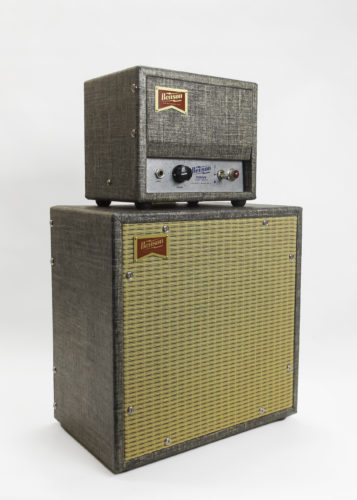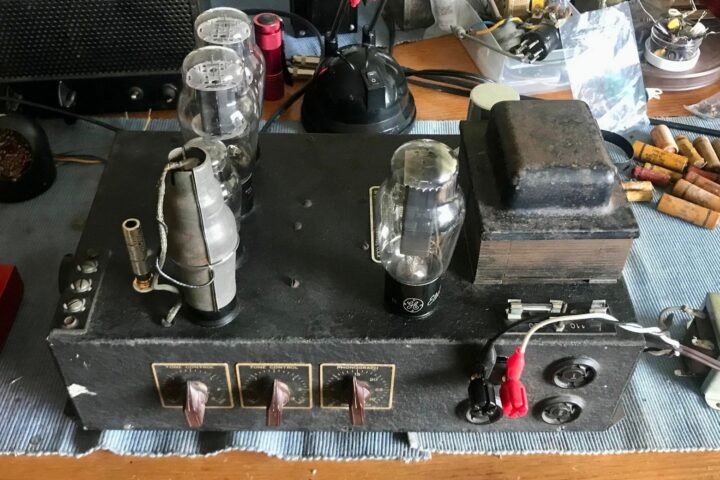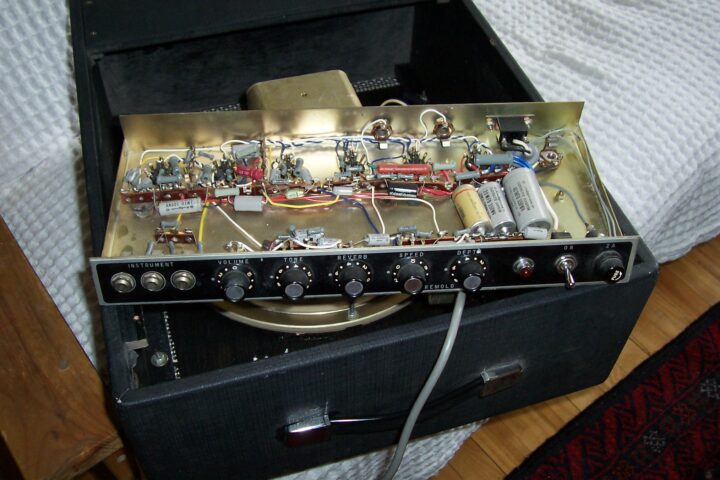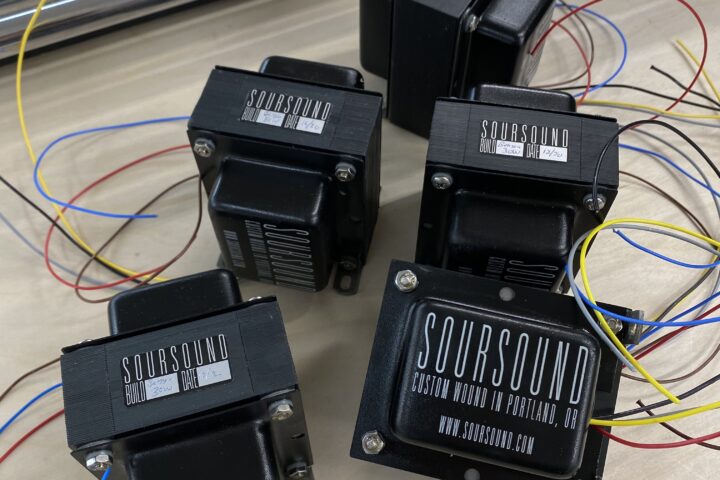Benson Amps have been popping up left and right over here at the Fretboard Journal. First there was the guitar/amp-in-case that Christopher Benson made in collaboration with Nic Delisle of Island Instruments (and subject of a previous Bench Press). Then we noticed that Daniel Tyack of Salvage Custom (and also a subject of a previous Bench Press) has his own Salvage-wrapped Benson amplifier. And next thing we know, here’s Dan Phelps lugging almost the entire Benson line into the office for a visit. You’d think that’d be enough to get us thinking it’s time to talk to this guy, but, actually, it was catching a glimpse of a Benson on HBO’s Roadies that finally pushed us over the edge.
Chris officially opened Benson Amps in 2012 (though his Monarch design pre-dates that), after putting in time as a tech on the bench at Verellen Amps in Seattle and Old Town Music in Portland, Oregon. Like a lot of builders, particularly the younger ones these days, he’s also an active player, and that, plus his experience doing repairs, plays a big part in the design of Benson’s amplifiers. We reached out to Chris and ran him through the paces…
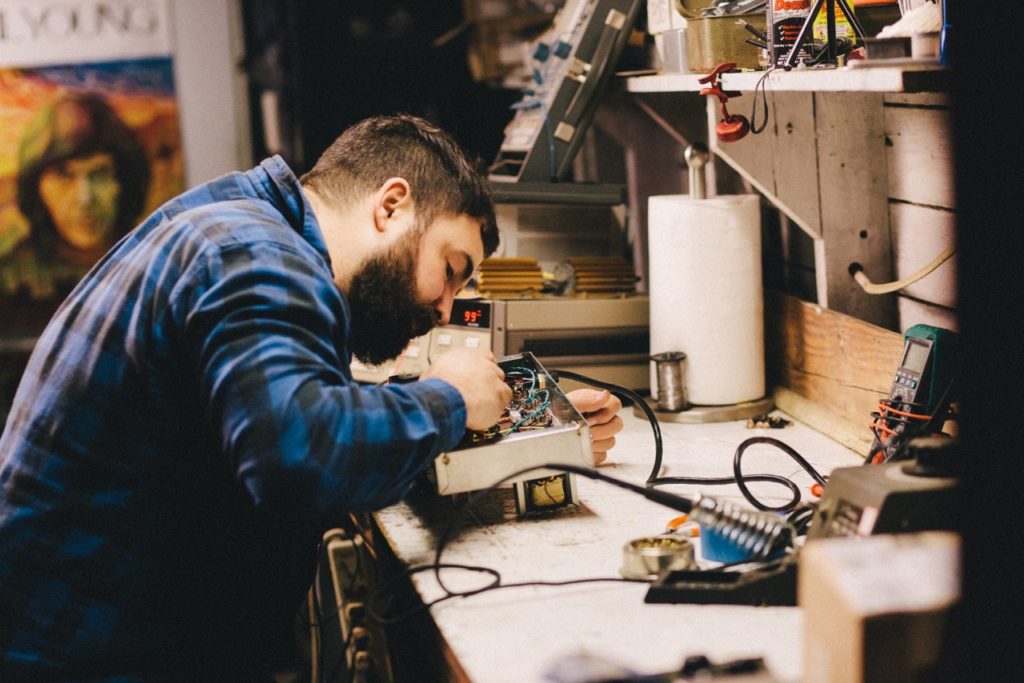
Fretboard Journal: What’s on your bench at the moment?
Chris Benson: A Tall Bird tube reverb circuit that I’m testing through the shop Vinny 1-watt amp (also sitting on the bench). And a coffee mug.
FJ: Can you tell us about the materials and construction techniques you’re using for the amplifiers you’re currently building? Anything unorthodox or new?
CB: I use pine dovetailed speaker cabinets for guitar amps, and baltic birch plywood for the bass amps. Pine is problematic in some ways because it’s slightly soft, is somewhat expensive (compared to what some use) and can be inconsistent, but its resonant qualities in guitar amp speaker cabinets are magical. I like how a speaker will activate the whole cabinet. I think of guitar speaker cabinets like acoustic guitars.
Bass cabinets are a different story…since the wattages are higher and air is being forced through ports somewhat unnaturally, the walls need to be proportionally stronger. A lot of guys swear by MDF, but I just…can’t. If something looks, smells and is composed of garbage, well, ya know. I use Baltic Birch that has a little resonance to add a little warmth and keep things durable.
My wiring is directly inspired by early Sunn amps. I remember opening up a Model T when I worked as a repair tech at Verellen in Seattle and saying “Oh, that’s the strongest way to wire an amp”. There was no circuit board…everything was wired directly to terminal strips. Wiring true point to point can look a little intimidating if someone is used to a well laid out turret board or whatever, but I’m content knowing if one of my amp is thrown off a building the cabinet is going to crumble well before any wires or components come loose. As a repair tech I got to see how many problems are caused by the use of printed circuit boards in a tube amp environment with radical temperature swings and vibrations. Some people say you can design a printed circuit board to be just as reliable as point to point, but I’m not really that interested in finding out. I’m not trying to cut costs and increase manufacturing speeds, I’m trying to make the best sounding, most roadworthy amp I can.
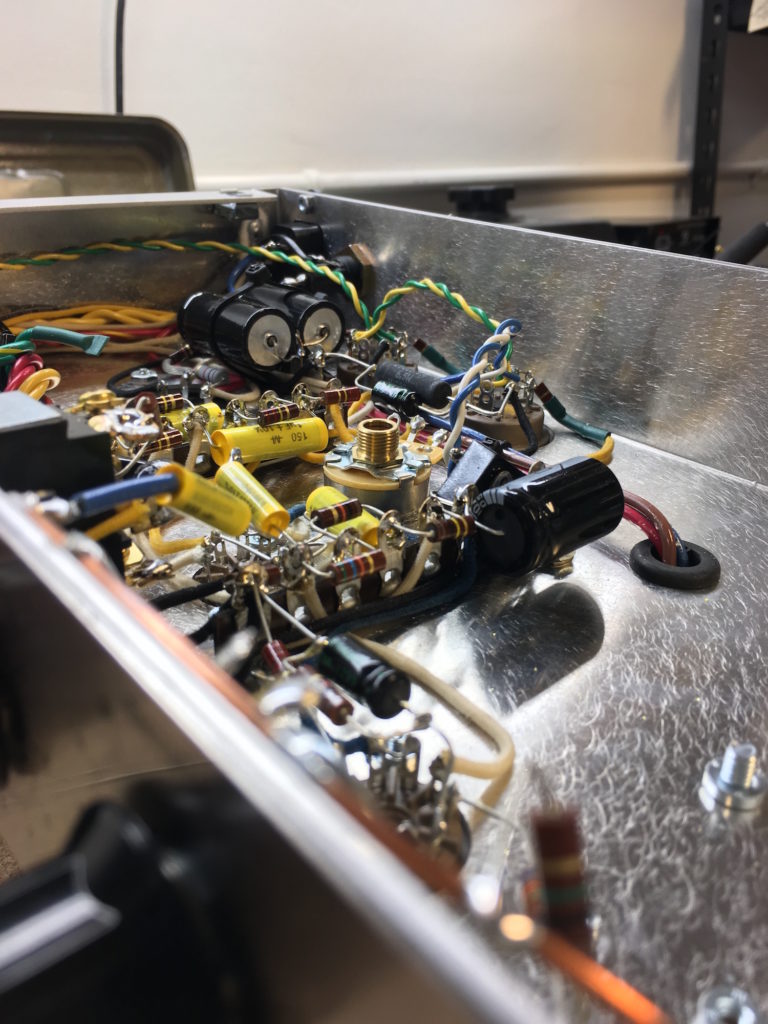
FJ: Do you have a “Gold Standard” or a particular tradition that inspires your amps?
CB: I love most vintage amps…it’s interesting to see the triumphs and failures in design, and trace traditions and pieces of circuits through various companies as they competed with and copied each other. It’s fun to look at an Ampeg circuit where it’s obvious they had their own engineers who wouldn’t stoop to cloning or borrowing, and it’s fun to see things like how a transpositional error in copying a Gibson circuit led to the Vox Top Boost sound. Or how The Harmony H420 is an incorrectly copied Supro Thunderbolt (probably from the same factory). That being said, I pick the parts I like and leave the rest. My circuits all have bits of Marshall, Vox, Fender, Mesa Boogie, Supro, Ampeg etc., along with a couple of ideas I haven’t seen before, all of which has been motivated by my own tone chasing. The sound of my amps has been described as a punchier Tweed, or a Supro with more clarity. It’s been really interesting to see what people think both when they first plug in, and again after a few hours when they get used it it. I get a lot of “uhh this thing is crazy different”.
FJ: You make a point of not quite buying into the NOS tube thing, sticking with JJs. Can you tell us a bit about your thinking? Is it particular to your designs, or a general philosophy?
CB: My theory is that people are obsessed with tube swapping because it’s an easy way non-techs can change the sound of their amp…they’re talking about making a 5%, albeit real, change to the sound, and there’s nothing wrong with that. Being a tech and designer, I can change the sound completely by making one circuit change. It’s the difference between painting a wall and designing a house to live in. I like vintage tubes, mainly because they’re more rugged and most times, when I test them, they’re still working great after 40-50 years. And yeah, sure, there are some sonic differences, but they’re hard to get excited about when tweaking a phase inverter topology makes a difference about 100 times more noticeable. My philosophy is, I want a band on tour to be able to find the same tubes that amp is designed around in a music store in Kansas or Montana if something goes wrong. It’s the same reason I design around popular tubes (even though I dig esoteric ones)…my amps are for professional musicians who face real problems if their gear doesn’t work….I don’t want them to be chasing down a 13By4-whatever tube that isn’t being made anymore when they’ve got to play later that night. I use 12ax7s and 6V6s for the same reason light bulbs are the usually the same size.
Being a repair tech has made the decision to go with JJ very easy. Sovteks don’t seem to last very long. The Chinese tubes tend to rattle and are made of thinner glass. NOS tubes, if you can find them, are too expensive for working musicians and who knows where that dude on eBay got them? JJ’s last a long time, are relatively cheap, and to my ears, they sound consistently great. They’re not perfect, but I buy them from Ruby who does an excellent job of testing and has a great warranty. Buying new tubes is also investing in the future…I think it’s the golden age of tube amps and the demand for high quality tubes is increasing. Given time and opportunity tube manufactures are going to get better. I know the guys at Eurotubes here in Portland, who have a close relationship with JJ. I gave one of their employees some feedback on why I don’t use one of the JJ products thinking I was doing some harmless bitching about a faceless corporation on the other side of the planet, and then I was told the next day they spent a bunch of time verifying what I was saying. I don’t know if it’ll truly lead to a change in production, but the feeling I took away was, “Wow, they truly want to get better and it’s as simple as telling them.” I want to give current manufacturers my business. I don’t spend too much time on the internet fretting about what people say about JJ tubes. I’d rather focus on the amp designs because that makes a greater difference in the sound.
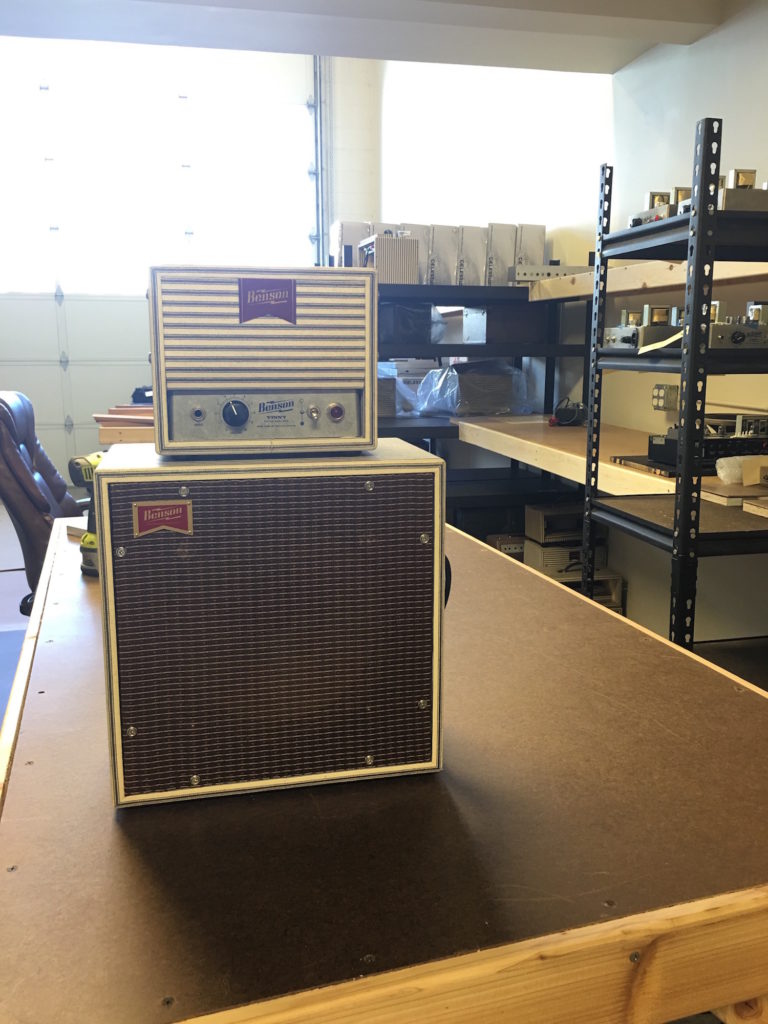
FJ: We’ve got a bit of a thing for “One-Knob Wonders;” what can you tell us about your one-knob, 1-watt amp?
CB: The Vinny was originally designed for my friend Blake of The Tone Mob and Chasing Tone podcast. Well before he was even on the internet as a…personality? Tastemaker? I’m not sure. He’s like a savant when it comes to that stuff. Anyway, he used to come to Old Town Music in Portland where I was the resident amp tech and brought me stuff to fix and mod. He ended up getting a Monarch from me that I wrapped in material that his grandfather left him when he passed away. Then, he wanted a little 1-watt to commemorate the birth of his son Vinny in the same material, and I had just enough scraps to make it work. Blake basically wanted something that made sound and wasn’t expecting much, but I have an obsessive personality when it comes to circuit design, and went though about 60 hours and about six different types of circuits to come up the Vinny. I did the last circuit change the morning Blake was one his way to pick it up, and I haven’t changed a thing since…I’m very proud that it sounds like a big amp, that it has a wide range of chimey cleans all the way to fuzz. I put an instrument level output on the back as well…when a speaker isn’t plugged in a load resistor becomes active…the Vinny used as a preamp can make a Peavey Bandit sound like it has glorious real power tube distortion and response because that is exactly what’s happening! You don’t even have to use the Transtube Technology. The Vinny is the only amp I personally own at the moment… I plug it into my guitar player’s Twin and get the response and breakup I’m accustomed to at whatever volume I want. I’m going to make myself a Monarch Reverb combo though!
FJ: We recently chatted with Daniel at Salvage Custom and noticed you’ve done a couple projects with him. How did those come about?
CB: Daniel and I came up with the striped ticking look around the same time, probably strolling around Joann Fabrics on the same afternoon in 2009 getting weird looks from the ladies 1000 miles apart. Years later, I noticed his work on social media, and I was afraid he would think I copied his look. I got added to a forum a couple years ago that Daniel was active in and the first thing I messaged to him was, “Dude, I swear I wasn’t copying you.” He apparently shared that exact same nervousness and was afraid I would think he had copied me. Needless to say we were both relieved, and we’ve become good friends…kinda cut from the same cloth! I have a lot of admiration for the finishes that Daniel does and own one of his pedal boards…he’s got a Monarch he covered in crazy floral fabric and is getting a fuscia Benson badge made for it. He’s done a few amps for me…the most notable being a black tweed Tall Bird for Kyle Hunt (The Black Angels), and a black tweed Gnostic bass rig for Yuuki Matthews (The Shins, Sufjan Stevens, David Bazan). We talk all the time…wrapping stuff in fabric and finishing it well is a poorly documented black art where 1,000 things can go wrong so it’s nice to have a friend to share ideas with.
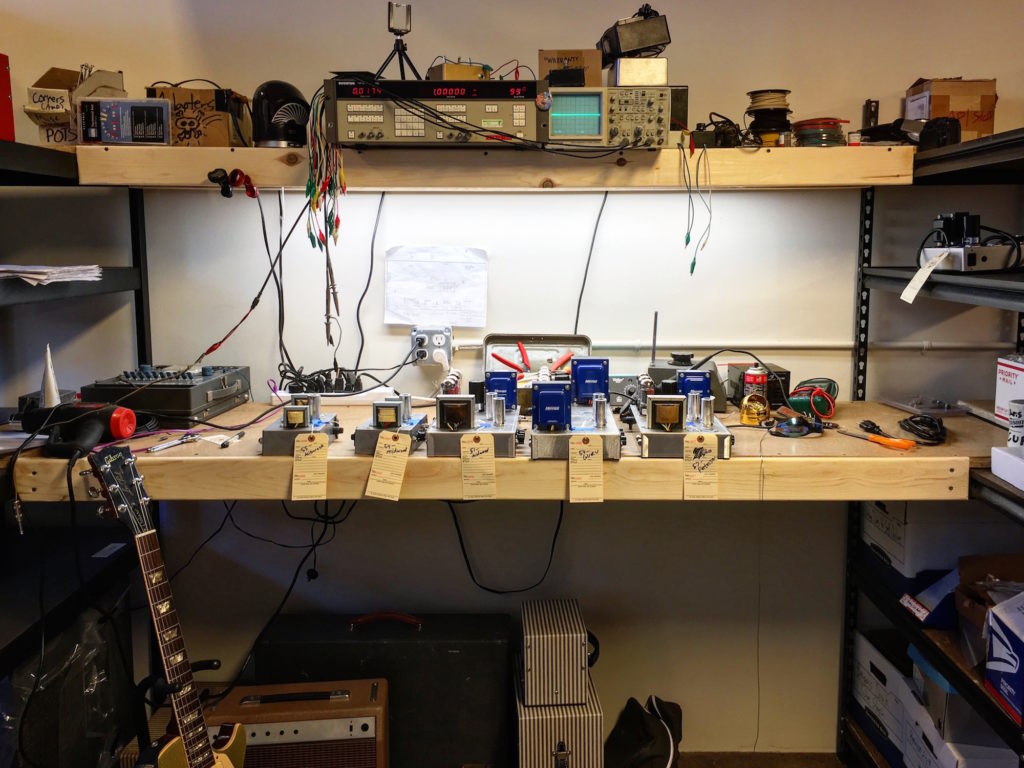
FJ: While we’re on the subject of collaborations, you’ve also done an amp-in-case for Nic Delisle, of Island Instruments.
CB: Yes. It’s called the Drifter and that has been a really fun project! It started as a straight clone of the Silvertone 1457 amp-in-case, but we weren’t 100% happy with how the circuit sounded. Last year Nic asked me to design something else for that chassis and I basically wired up a 5-watt version of the Monarch with tremolo. After I sent him that one he freaked out on the sound and ordered a Drifter combo amp for his shop, which is hopefully getting built this weekend. I have one of Nic’s Traveller guitars with a Roadhouse KT-200 pickup in it and it sounds unbelievable!
FJ: Anything coming up in the future you are particularly excited about?
CB: We’re about to release the Monarch Reverb combo. There are three of them in existence so far and we’ve got about 10 in our queue but they haven’t been “released” yet. I need to find some time to put it on the website but we just moved shops and things are crazy. I’m also working on a weird custom reverb amp for L.A. guitarist Josh Smith, and I have an ongoing tube-driven optical vibrato project (true pitch shifting!) with Seattle guitarist Dan Phelps. I’m not expecting to sell much of either because their uses are so esoteric, but it’s fun!
FJ: Where is your shop located? Anything unique or interesting we should know about your space?
CB: We just leased a 1200 square foot commercial space in Portland near the Aladdin Theatre. It’s in a cool area, very high ceilings and and a large loading door. Apparently it’s fine to host shows here, which we are definitely going to do. We are also accepting some repair and modification. I just hired another full time tech to take some of that on, as well as make sure we’re keeping up on the production side of things.
FJ: What’s your wait time?
CB: We’re sitting around four months. We have a backlog of about 75 amps. Hence the increase in production and new space.
FJ: Have you met the guys in the Staton-House Band? What are they like?
CB: Well, I just Googled that. Roadies… Ha! I shoulda known. Peter Lalish from the band Lucius tours with a Chimera and I watched the whole episode that featured them because people told me my amps make an appearance. It was very dramatic.

